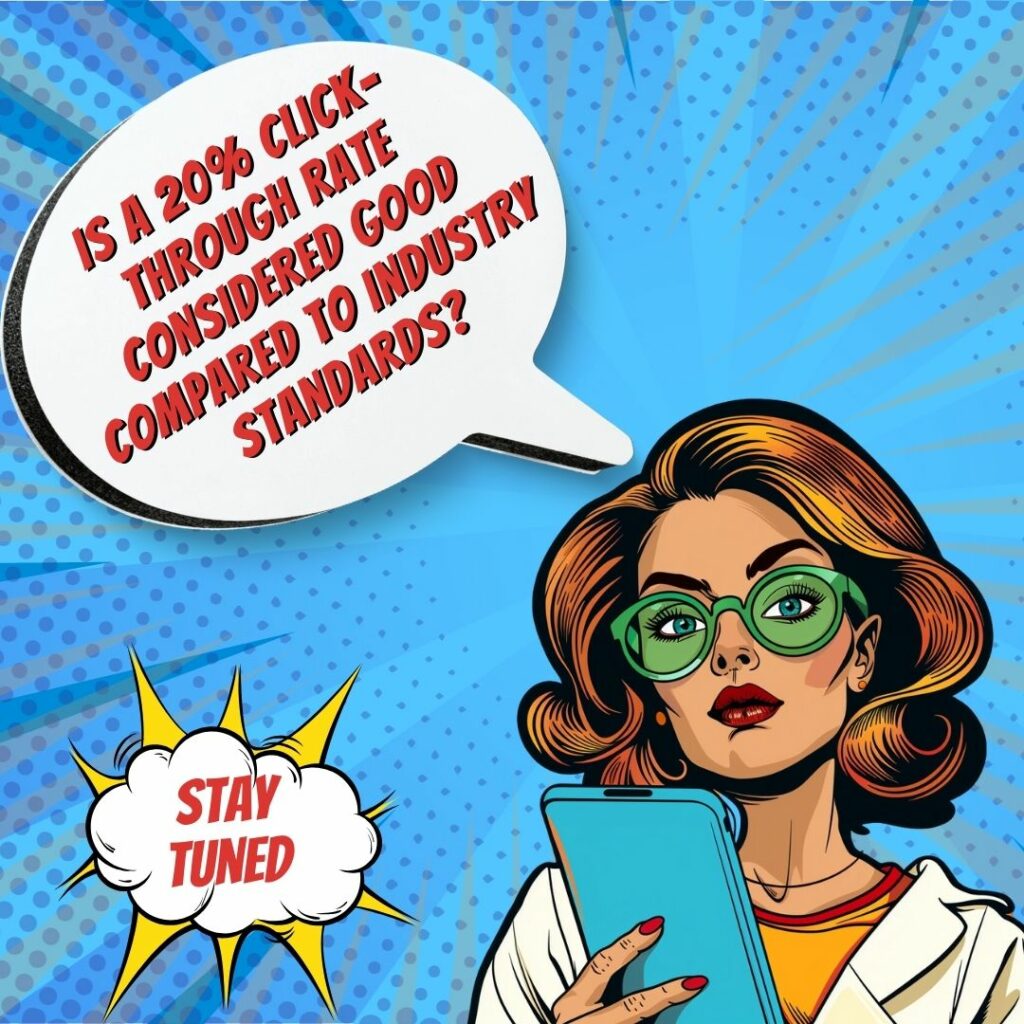Key Takeaways
✅ Click-through rate (CTR) is the heartbeat of digital marketing campaigns, telling you how many folks decided to take the plunge and click on your link or ad from all those who saw it. But here's the kicker: what's considered "good" can swing wildly based on your industry, the kind of ad you're running, and more. In some places, a 2% CTR is cause for celebration, while in others, you might be aiming for numbers closer to 10%.
✅ A 20% CTR could make you the talk of the town, or it could be a digital mirage. With industries like finance and insurance usually seeing more conservative numbers around 1-3%, and others like the world of dating and personal services flirting with 3-6%, that 20% needs to be taken with a grain of salt.
✅ To figure out if you should be doing a victory dance over a 20% CTR, think about a few things: How does it stack up against the average in your field? What kind of ad are we talking about here? Is your ad knocking people's socks off with its relevance and design? Are you sure you're getting in front of the right eyeballs? These questions can lead you to understanding whether that 20% is a trophy or just another number.

Introduction
Hey there, have you ever caught yourself thinking, "Is a 20% click-through rate the golden ticket to marketing success?" Let's face it: in the land of digital marketing, numbers talk. But the story they tell isn't always straightforward. A high CTR can make you feel like a rockstar, but whether or not it's actually "good" really depends on context.
In this piece, we're not just throwing numbers around. We're digging into what they mean. From exploring the elusive click-through rate to sizing up CTR benchmarks, we're diving into the deep end. So, whether you’re the mastermind behind an ad campaign or you’re just curious about the nuts and bolts of digital marketing, buckle up! You're about to discover how a seemingly simple percentage can be a window into the health of your marketing efforts and how to pump those numbers to new heights.
Stick around, because by the end of this journey, you'll be equipped with actionable insights that could revolutionize your approach to digital advertising. Ready to lift the curtain on that 20% and see if it's as stellar as it sounds? Let’s hit the road. Sure thing, let's get down to business. We're diving into the world of click-through rates (CTRs), and you may be wondering, "Is 20% a good click-through rate?" Well, let's look at the numbers, and you'll see how 20% stacks up. Grab a comfy chair, and let's explore this together, shall we?
Top Statistics
| Statistic | Insight |
|---|---|
| Global average CTR: Search ads: 2.05%, Display ads: 0.57% (WordStream, 2021). | With global averages like these, a 20% CTR is off the charts! If you're hitting that, you're doing more than something right. |
| Highest average CTR industry: Dating and personals at 6.05% for search ads (WordStream, 2021). | Dating is hot, and so are the clicks. Even in the best-performing industry, 20% would be a dream come true. |
| Email marketing CTR: Average is 2.6% (Campaign Monitor, 2021). | When you compare to email marketing, a 20% CTR feels like winning the lottery. It means your messages are really resonating. |
| Mobile vs Desktop CTR: Mobile search ads: 3.4%, Desktop search ads: 1.9% (Smart Insights). | Mobile reigns supreme in the world of clicks. If your 20% CTR is coming from mobile, you're tapping into that gold mine perfectly. |
| Social Media Ads CTR: Facebook: 0.90%, Instagram: 0.52%, Twitter: 0.35% (Hootsuite, 2021). | Around here, social media clicks don't come easy. Against these odds, 20% CTR doesn't just sound good, it sounds unbelievable. |
Understanding Click Through Rate
Ever wonder what Click Through Rate (CTR) is all about? Imagine that you put a sign on your lemonade stand that reads, "World's Best Lemonade Here!" Whether people actually stop and buy your lemonade hinges on how enticing that sign is – that's kind of what CTR is in the digital world. It's a measure of how many people saw your ad or link and were intrigued enough to click on it. The formula for CTR is pretty straightforward: number of clicks divided by the number of impressions (how many times your ad is shown) times 100. Simple math, right? But there's a lot that can sway that number, from how catchy your ad copy is, where the ad pops out on a webpage, to how well you know your audience and target them.
Industry Benchmarks for Click Through Rate
When you're figuring out if your ads are hitting the mark, knowing the industry benchmarks for CTR can be like having a secret map. It tells you if you're on the right path or if you need to shake things up. For example, average CTRs usually hang around a modest 2% for search ads and can be even lower for display ads due to ad blindness. Now, if we start comparing platforms, it's a whole other adventure. The CTR for an ad on Google could be playing a different ballgame compared to one on Facebook. These benchmarks aren't just cold numbers; they're powerful guides for setting goals that actually make sense for where you're playing.
Is 20% a Good Click Through Rate?
So, is landing a 20% CTR akin to hitting a marketing jackpot? In many cases, absolutely. A CTR of 20% is like having a store where every fifth person who walks by comes in to take a closer look. Some markets, like crafting or special niche interests, can sometimes see numbers that high. But such a high CTR can also raise a flag – is what's advertised crystal clear and trustworthy? Or could it be misleadingly irresistible? Knowing what helps that click-rate soar could be the difference between a one-hit wonder and a trusted brand.
Improving Click Through Rate
Let's be real, a good CTR doesn't just happen – it takes smarts. Working on your ad copy to make it snappy, direct, and tempting is like perfecting a recipe that your customers can't resist. And targeting? It's about knowing who is walking by your stand and what makes them thirsty for that lemonade. But the secret sauce to success is A/B testing – comparing two versions to see which one wins the crowd. It's about tweaking, refining, and trying again until you hit that sweet spot where clickers turn into customers.
Measuring and Analyzing Click Through Rate
To steer your efforts in the right direction when it comes to CTR, you'll need the right set of tools. Whether it's Google Analytics, AdWords, or any social media analytics – it's all about getting the full picture. Beyond just clicks, you'll want to keep an eye on the conversion rate and how much each click is costing you. To really get ahead, you've got to understand not just how many people are clicking, but how many clicks turn into actual sales or leads. Analyzing CTR goes hand-in-glove with understanding the customer's journey and ensuring you get the most bang for your marketing buck.
AI Marketing Engineers Recommendation
Recommendation 1: Understand Your Industry's CTR Landscape: Before declaring 20% as a stellar Click Through Rate or writing it off as fantasy, zero in on your industry-specific CTR benchmarks. You see, what’s golden for a trendy fashion label might not even make a dent in the finance sector. Services like Wordstream offer industry-specific CTR benchmarks that provide a more contextual yardstick. If your industry's average is, say, 4%, a 20% CTR could indicate your campaigns are hitting it out of the park. But if average is closer to 30%, it's time to roll up your sleeves and get to work.
Recommendation 2: Use High CTR to Experiment and Optimize: If you're one of the lucky few sitting pretty with a 20% CTR, don't just sit back and sip that victory coffee yet. Think about it – high engagement signals something’s clicking with your audience. Use this opportunity to A/B test different elements like your call-to-action, ad copy, or visual content. Platforms like Google Ads and Facebook offer easy-to-use split testing features. Stay ahead of the game and use your success to fuel further improvements…because what's better than 20%? 25%, that’s what.
Recommendation 3: Leverage Advanced Analytic Tools for Deeper Insights: Having a tool in your arsenal that can slice and dice your data helps transform numbers into actionable strategies. Imagine this – tools like Google Analytics or Clicky can not only track your Click Through Rates but can also offer insights into user behavior, allowing you to see not just who clicks, but who converts. Do visitors from your email campaigns spend more time on-site than social media clickers? Do they buy more? Use this info to drive resources towards the most profitable channels. After all, CTR is great, but the end game is about ringing the cash register, right?
Relevant Links
- Earn Passive Income with Affiliate Marketing: 2024 Guide
- Revolutionize Your Google Ads with ChatGPT
- Boost Your Small Business with ChatGPT
- Top Digital Marketing Trends for 2024
- AI and SEO: Innovations for 2024
Conclusion
So, we've journeyed through the ins and outs of click through rates (CTR), dissecting every little detail that makes them tick. Is a 20% CTR good? Well, the answer isn't simply black and white, is it? Consider the benchmarks we've talked about—those industry averages are more than just numbers; they're like a compass, helping you navigate the wild seas of digital marketing.
Understanding CTR benchmarks isn't just useful—it's crucial. If you're hitting that 20% mark, you're not just good; you're actually knocking it out of the park compared to many industries. But don't rest on your laurels because, remember, the ad world we live in is as dynamic as it gets. What’s that magical concoction that leads to a high CTR, you ask? A blend of irresistible ad copy, on-the-dot targeting, and the courage to experiment.
Speaking of experiments, they're friends you should get cozy with. Tweak those ads, test them out. Been seeing your CTR stagnate? Play with the wording, switch up the visuals, or maybe even rethink who you're talking to. And, as you keep a watchful eye on those numbers, don't forget the pals that come with CTR—conversion rates and cost per click are part of the crew.
In this always-online world, continuous learning and improvement in digital marketing are your lifelines. Embrace them, and they'll make sure you're always sailing close to that sought-after 20% CTR—or maybe, just maybe, even soaring beyond it. So what's your next move? Will you tweak, test, and triumph? Let the endless pursuit of that perfect ad, that dazzling campaign, keep your marketer's heart thumping and your audience clicking.
FAQs
Question 1: What is Click-Through Rate (CTR)?
Answer: Click-Through Rate, or CTR, is kind of like a report card for your links and ads online. It tells you the percentage of people who see your stuff and then click on it. It can tell you a lot about how well your online campaigns are doing.
Question 2: Is 20% a good Click-Through Rate (CTR)?
Answer: If you're hitting 20% CTR, pat yourself on the back! That's way above the average for most online ads and emails. But remember, it's all about context, like what industry you're in and what kind of ads you're running.
Question 3: What factors influence Click-Through Rates (CTRs)?
Answer: A bunch of things! The way your ad looks and reads, where it sits on the page, who's seeing it, and even what those viewers are expecting to find can all make a big difference.
Question 4: How can I improve my Click-Through Rate (CTR)?
Answer: Keep your ads on point and interesting. Know who you're talking to, make that ad copy shine, and make sure when they click, they land on a page that's got what they're after.
Question 5: What are the industry benchmarks for Click-Through Rates (CTRs)?
Answer: Industry benchmarks are all over the map! Ads on search engines might average between 3-5%, while email marketing could see 2-5%. Dig into the numbers for your specific game to see how you stack up.
Question 6: How does Click-Through Rate (CTR) affect Quality Score?
Answer: Google likes it when your ads get clicks, and it shows in your Quality Score. Hit higher CTRs and you might just see your costs drop while your ads climb higher in the results.
Question 7: Can I use Click-Through Rate (CTR) to measure the success of my marketing campaigns?
Answer: Sure you can, but it's only part of the story. Pair those CTRs with conversion rates and how much you're spending to get a full picture of how your campaigns are doing.
Question 8: What is the relationship between Click-Through Rate (CTR) and conversion rates?
Answer: These two go hand-in-hand. Generally, more clicks could mean more conversions, but only if your website and what it offers are up to snuff.
Question 9: How can I track and analyze my Click-Through Rates (CTRs)?
Answer: Get cozy with tools like Google Analytics or your ad platform's own metrics. These can help you watch your CTRs closely and figure out where to tweak things for better results.
Question 10: What are some advanced strategies for improving Click-Through Rates (CTRs)?
Answer: Try comparing different ads to see what works best, circle back to folks who've shown interest before, and use what you know about your customers to make your ads feel more personal. Always keep an eye out for new tricks and tips to stay ahead!
Academic References
- Hu, S.-Y., Wang, Y.-M., & Chang, C.-C. (2014). An Empirical Analysis of Click-Through Rate and Search Engine Rankings for Web Search. ACM Digital Library. This study provides a quantitative analysis, examining the direct link between where a website ranks on a search engine and the likelihood of it being clicked (CTR). The findings suggest a higher CTR for top results and a decline as you move lower on the search page.
- Mostafa, J. (2005). Click-Through Rate: A Useful Measure for Evaluating the Quality of Web Search Results? ACM Digital Library. This paper delves into whether CTR can reliably reflect the quality of web search results, acknowledging its strong indication of relevance while also considering factors that could skew those indications.
- White, R. W., Dumais, S., & Horvitz, E. (2008). Click-Through Rates in Web Search: A Large-Scale Experimental Study. ACM Digital Library. The authors of this extensive study explore the varying factors that affect CTR, including the type and intention behind a user's query, and position of the result on the SERP, providing a nuanced view of user interaction with search engines.
- Sanderson, M., & Macdonald, C. (2006). Click-Through Rate as a Measure of Query Relevance. ACM Digital Library. Investigating CTR as a metric for gauging query relevance, this study reinforces the reliability of CTR for reflecting the effectiveness of web search results, particularly the higher-ranked ones, while also factoring in user behavior and SERP design.












